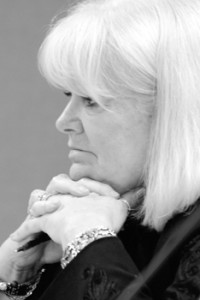IN THIS POST: noting board disquietude, early in 1975, Norrisa Brandt of the Saddleback board of trustees calls for a discussion of the very idea of a community college—and of the longterm goals of the district.
Ten months later (January, 1976), new trustee Frank Greinke of Tustin senses board disunity concerning THE BIG ISSUE—namely, the district's second and northern campus. To get things moving, he proposes establishing a citizens advisory committee with two community members chosen by each trustee—a procedure guaranteeing strong representation for the City of Tustin.
The bumptuous Mr. Greinke approaches the Tustin City Council, asking them for a resolution “supporting the concept of a Tustin area campus of Saddleback College.” They provide it. Meanwhile, conservative trustee, Bob Bartholomew, carps brutishly about the faculty's proposed campus calendar, claiming that it reflects selfish faculty interests. Here and elsewhere, the board is divided between a conservative faction (Bartholomew, Berry, and perhaps Greinke) and a more progressive faction (Taylor, Brandt, Marshall).
 In May, conservative trustee Donna Berry, seeking to reduce district costs, leads a successful effort to eliminate the "6 unit rule," a rule allowing Tustinites (and other Saddleback district residents) to transfer to other districts' colleges (e.g., Santa Ana College) without securing permission paperwork. The upshot is fewer transfers, lower "tuition" costs for Saddleback.
In May, conservative trustee Donna Berry, seeking to reduce district costs, leads a successful effort to eliminate the "6 unit rule," a rule allowing Tustinites (and other Saddleback district residents) to transfer to other districts' colleges (e.g., Santa Ana College) without securing permission paperwork. The upshot is fewer transfers, lower "tuition" costs for Saddleback.Natch, Tustinite trustees (Greinke, Backus), aware of their constituencies' desire to attend Orange Coast and Santa Ana Colleges, fail to support Berry's cost-cutting move.
Trustees confront a likely financial shortfall of about $3 million caused by new legislation. They pursue cost-cutting and new revenue more vigorously. They consider charging costs to students who take non-credit craft courses and the like. Discussion of this option brings out philosophical differences between trustees concerning the nature of "college."
 In mid-May, the Citizens Advisory Committee provides its report concerning pursuit of a second, northern campus. It urges the board to buy land (for a 2nd campus) immediately. It highlights longterm complaints especially among Tustinites about the distance to Saddleback college.
In mid-May, the Citizens Advisory Committee provides its report concerning pursuit of a second, northern campus. It urges the board to buy land (for a 2nd campus) immediately. It highlights longterm complaints especially among Tustinites about the distance to Saddleback college.
The college produces a document concerning "priorities," but some trustees carp that it does not sufficiently emphasize vocational and technical (even agricultural) instruction. Trustees feel pressure to increase taxes for maintenance, repair, construction, and (mostly uncompensated) growth while attempting to honor conservative anti-tax desiderata. Meanwhile, Saddleback faculty move to strengthen their union. Sparks fly.
Philosophical differences again arise when Superintendent Lombardi reveals a document describing the kind of college the district is attempting to create. Lombardi's collegiate assumptions clash with local notions.
Pursuit of a second campus continues. By September (1976), three sites are under discussion: on Myford, east of the Santa Ana Freeway; on Culver, west of the freeway; and on Jeffrey @ the Santa Ana Freeway. The board is very divided, and worries about costs and taxes resurface. Greinke, of Tustin, insists that the Myford site (@ today's Tustin Marketplace) is ideal. Tustinites commence clamoring for the Myford site, feeling entitled to a campus in or near Tustin. On a 5-1 vote, Berry dissenting, the board chooses the Myford site. While Tustin celebrates, trustee Bartholomew carps about the immorality of Day Care Centers.
In November, Bartholomew resigns and moves to Carpinteria. The board is down to six members.
In January, the Irvine Co. upsets the applecart by attempting to withdraw its offer of the Myford site, recommending, instead, a new site at Jeffrey and Irvine Center Drive in Irvine. Its motives seem obscure. Meanwhile, the Tustin City Council behaves oddly with regard to the annexation and zoning of a 425 acre parcel owned by the Irvine Co—and including the Myford site.
With the Irvine Co.'s withdrawal of Myford, SHIT HITS FAN. HORNSWOGGLERY SUSPECTED. —RB
Philosophical differences again arise when Superintendent Lombardi reveals a document describing the kind of college the district is attempting to create. Lombardi's collegiate assumptions clash with local notions.
 |
| Greinke |
In November, Bartholomew resigns and moves to Carpinteria. The board is down to six members.
In January, the Irvine Co. upsets the applecart by attempting to withdraw its offer of the Myford site, recommending, instead, a new site at Jeffrey and Irvine Center Drive in Irvine. Its motives seem obscure. Meanwhile, the Tustin City Council behaves oddly with regard to the annexation and zoning of a 425 acre parcel owned by the Irvine Co—and including the Myford site.
With the Irvine Co.'s withdrawal of Myford, SHIT HITS FAN. HORNSWOGGLERY SUSPECTED. —RB











